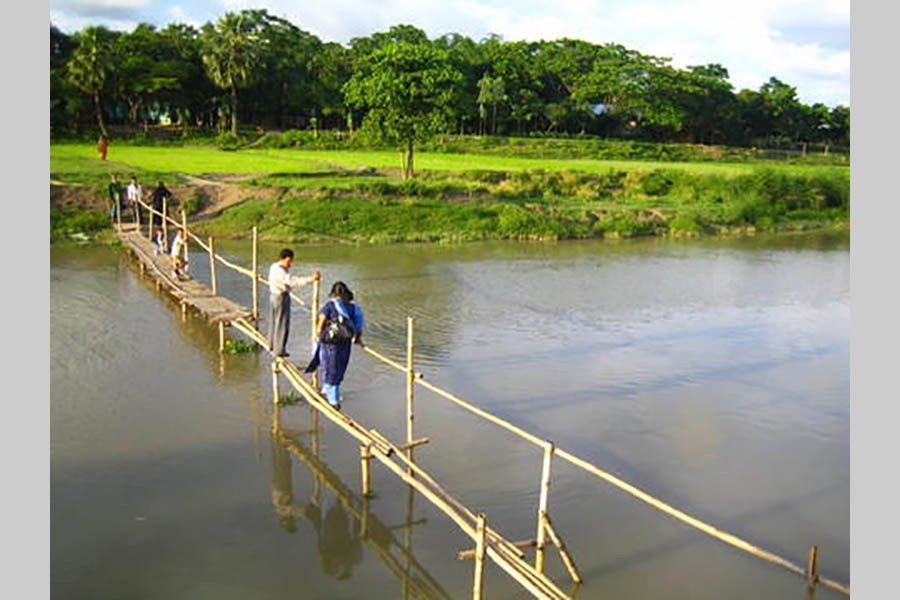Hardly does a week pass without a photograph in the print media showing rural people crossing a canal or a small river by walking on bamboo-made bridges. In these days of amazing rural uplift in the country, these bridges are anachronism incarnate. But villagers have to live with them, no matter how terrible their look is and what an experience of ordeal their use turns out to be. In place of briskly walking people, one watches their cautious steps as they climb on them.Women of all ages avoid these so-called bridges.The makeshift bamboo structures erected across dying rivers or moribund canals are locally known as 'shako'. It is a primitive form of crossing water bodies. They exist alongside collapsed concrete bridges in this country. The latter are built by the local public representatives elected by the rural people.
In the first 1/2 decades after they are built, the concrete bridges function properly. Slowly some of them begin to show signs of decay; proving corruption of all conceivable ways, related to the bridges' construction. This is the so-called part and parcel of bridge construction in the country's vast rural areas. Given the corrupt tendencies getting rooted in the rural areas' bridge construction,the future appears to be bleak. The days are not far when concrete bridges might emerge as objects of wonder --- with 'shakos' built at all critical points of rivers and canals. The startling part of the whole episode is the village people are least bothered to know why a concrete bridge collapses in the middle for no strong reasons and in barely a year after its construction. They only know the time has arrived once again to get down to the task of collecting bamboos and starting the construction of a new 'shako'. After a long futile wait in silence for the authorities to intervene, the villagers nowadays construct 'shakos' on voluntary labour. A great number of these improvised bridges now dotting the country can be considered the result of people's inability to go through miseries any more. The local government functionaries are well aware of the graft-ridden rural bridge sector. They hardly come forward with remedial measures for reasons they know better.
A 'shako' has been a common sight in the country's villages for ages. With the advent of the construction of concrete-and-iron bridges on pillars over half a century ago, wide swathes of the rural Bengal appeared to have entered the modern era. Glimpses of both short-length and long concrete bridges among bamboo or wooden 'shakos' started to become a common sight in villages. In a land of natural calamities like floods and super-storms, the collapse of these bridges was once a common phenomenon. With the bridges caving in due to flooding and other disasters, villagers would waste little time to build 'shakos' beside the collapsed bridges for emergency uses. In many case, these makeshift bridges would stand for an indefinite period. However, the presence of 'shakos' remained integral to rural communications for long. Both types of bridges comprised the normal village spectacles in the river-filled East Bengal, later Bangladesh.
In the second decade of the 21st century, one must visit the sprawling rural areas to see how 'shakos' dominate the rural landscape. The bamboo bridges, built on weak foundation, and thus wobbly and hazardous, are standing everywhere. They might prompt many outsiders to think that a miracle may have caused new river branches and canals to flow through parched areas. In the age of the under-construction mega structure of the 6.15 km Padma Bridge, the sights of the ubiquitous 'shakos' seem to have taken out from the page of a European 'absurd drama'.


